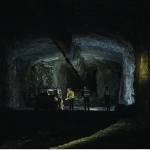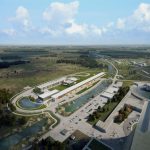From Science News, September 22, 2022: Emily Conover explains in this video why the universe contain so much more matter than antimatter told through the lens of a classic, 8-bit video game, with matter and antimatter locked in an epic battle for cosmic supremacy. Experiments like DUNE will examine ghostly subatomic particles known as neutrinos to provide clues.
DUNE
From Scientific American, September 8, 2022: What came out of Snowmass 2022? In late July, nearly 800 particle physicists met for over 10 days for the once-a-decade Snowmass process to discuss and build a unified scientific vision for the future of particle physics. Find out what Fermilab director Lia Merminga presented and more about discussions around DUNE, diversity, SUSY, the LHC, future colliders and more.
Excavation of the large caverns for the Long-Baseline Neutrino Facility is in full swing. Over a third of the whopping 800,000 tons that need to be extracted from a mile underground have been removed. When finished, the underground facility will cover an area about the size of eight soccer fields and provide space for the international Deep Underground Neutrino Experiment.
From The Big Think, July 8, 2022: Science writer and astrophysicist Ethan Siegel explores how the design of Fermilab’s DUNE experiment aims to detect neutrino oscillations from one flavor into another when neutrinos travel 1300 km through the earth.
From Physics Today, July 2022: Anne Heavey, senior technical editor at Fermilab describes how teams from around the world are developing and constructing detector components for the world’s largest cryogenic particle detector, the Deep Underground Neutrino Experiment (DUNE).
From Ceska Televize (Czech Republic TV-right click to translate the page to English), June 6: A delegation from the Czech Republic visited Fermilab last week in which the scientific collaboration between Fermilab and the Czech Republic on DUNE was highlighted by Fermilab director Lia Merminga. See highlights of the delegation’s tour and interviews with Lia and Fermilab scientist Jaroslav Zalesak.
The Department of Energy has formally approved the start of full construction for the PIP-II project, an upgrade to the Fermilab accelerator complex that includes a new linear accelerator. PIP-II is an essential enhancement that will power the world’s most intense high-energy neutrino beam. It is the first particle accelerator built in the United States with significant contributions from international partners.
From Innovation News Network, February 25, 2022: PIP-II project director Lia Merminga discusses the Fermilab accelerator complex upgrade being done in collaboration with research institutions in India, the UK, Italy, France, and Poland. Read more about the current status of PIP-II project, what it sets out to achieve and the impacts PIP-II will have on the future of particle physics research.
From The Conversation, December 21, 2021: Aaron McGowan, Principal Lecturer in Physics and Astronomy at the Rochester Institute of Technology explores research in 2021 in which physicists around the world ran a number of experiments that probed the Standard Model. From Higgs Boson, to Muon g-2 and the restart of the LHC at CERN, McGowan highlights some of the ways the Standard Model fails to explain every mystery of the universe.



